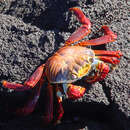en
names in breadcrumbs


Grapsus grapsus has been reported as prey of a variety of animals including the Galapagos Lava Heron (Butorides striata sundevalli) (Kushlan 2009) and other large birds, the chain moray (Echidna catenata) (Sazima and Sazima 2004), octopus (Octopus sp.) (Sazima and de Almeida 2009), and Kemp's Ridley sea turtle (Lepidochelys kempii) (Ernst and Lovich 2009).
Food consists largely of grazed algae (see, e.g., Vinueza et al. 2006), but G. grapsus is an omnivorous and opportunistic feeder, consuming items as diverse as bat guano and probably dead bats (Lopez-Foment 1981, cited in Arroyo-Cabrales and Jones 1988), green sea turtle hatchlings (Chelonia mydas) (Ernst and Lovich 2009), masked booby chicks (Sula dactylatra) (Anderson 1989), and food remains, broken eggs, and dead birds in Brown Booby (Sula leucogaster) colonies (Gianuca and Vooren 2007).
Beebe (1924) reported G. grapsus removing (and presumably consuming) ticks (Amblyomma darwini) from a Marine Iguana (Amblyrhynchus cristatus). This may indicate a symbiotic relationship benefiting both crab and lizard.
Johnson (1965) studied Grapsus grapsus on Oahu, Hawaii, and found that crabs in the study area spent nearly two thirds of their time inactive and hiding in crevices and nearly 20% of their time feeding. They were most active during low tide.
Graspus graspus often feed among rocks swept by surf, flattening themselves against the rock just before each wave hits. These crabs have complex intraspecific visual displays and displaying individuals are the last to prepare for each wave and the first to rise up again after each wave (Wright et al. 1968). When moving about, G. grapsus is strikingly fast and agile.
Guerao et al. (2001) describe the first zoeal larval stage of G. graspus and discuss implications regarding relationships with close relatives.
Florida to Brazil and Mexico to Peru; Galapagos Islands (Henderson 2002).
Rocky shorelines and beaches at and above the sprayline (Henderson 2002).
Grapsus grapsus has a carapace up to ~8 cm. It is highly variable in color and pattern, but often bright red, orange, and brown; young individuals are dark brown or black.
Grapsus grapsus is an excellent osmoregulator: it can maintain the water balance of its haemolymph (internal body fluid) within narrow limits in the face of external salinity ranging from 50% to 125% (Evans 2009) or 150% (Little 1990) seawater. This allows it to function well in a wide range of microhabitats along the shoreline.
Beninger and Larocque (1998) describe an accessory sex gland that in Grapsus grapsus produces a neutral mucopolysaccharide which they suggest may function (1) as a lubricant to reduce mechanical wear of the ejaculatory canal by the second gonopod during copulation, and (2) to reduce the viscosity of the ejaculate from the vas deferens as it enters the narrow ejaculatory canal.